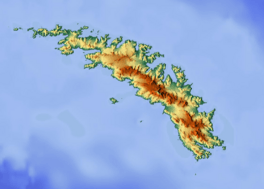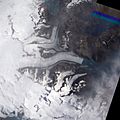Neumayer Glacier facts for kids
Quick facts for kids Neumayer Glacier |
|
|---|---|
| Location | South Georgia |
| Coordinates | 54°15′S 36°41′W / 54.250°S 36.683°W |
| Length | 8 nmi (15 km; 9 mi) |
| Width | 2 nmi (4 km; 2 mi) |
| Thickness | unknown |
| Terminus | Cumberland West Bay |
| Status | unknown |
The Neumayer Glacier is a large river of ice located on South Georgia, a remote island in the southern Atlantic Ocean. This glacier is about 8 nautical miles (15 kilometers) long and 2 nautical miles (3.7 kilometers) wide. It flows eastwards along the northern side of the Allardyce Range. It ends at the western part of Cumberland West Bay.
Contents
What is a Glacier?
A glacier is a huge mass of ice that moves slowly over land. Think of it like a very slow-moving river, but made of ice instead of water! Glaciers form in places where snow falls but doesn't completely melt away during the summer. Over many years, layers of snow pile up, get compressed, and turn into ice.
Glaciers are important because they hold a lot of the world's fresh water. They also help scientists understand how Earth's climate is changing. When glaciers melt or shrink, it can affect sea levels around the world.
Neumayer Glacier's Location and Flow
The Neumayer Glacier is found on South Georgia, an island known for its rugged mountains and icy landscapes. This island is part of the South Georgia and the South Sandwich Islands territory. The glacier flows down from the Allardyce Range, which is a mountain chain on the island.
It moves towards the sea, ending at Cumberland West Bay. The place where a glacier meets the sea or a lake is called its terminus.
A Changing Glacier
Like many glaciers around the world, the Neumayer Glacier has been changing. Between 2005 and 2009, this glacier retreated by about 1 kilometer (0.6 miles). When a glacier retreats, it means its front edge has moved back, or shrunk. This often happens when the ice melts faster than new snow can build up and turn into ice.
Scientists study glaciers like Neumayer to learn more about how our planet's climate is warming. The shrinking of glaciers is one sign of global climate change.
History and Naming
The Neumayer Glacier was first mapped by the Swedish Antarctic Expedition. This expedition explored the area between 1901 and 1904. The team was led by Otto Nordenskiöld, a famous Swedish explorer.
The glacier was named after Georg von Neumayer. He was a German geophysicist and explorer. He made important contributions to the study of Earth's magnetism and meteorology.
Gallery
-
Neumayer Glacier, Cumberland West Bay, South Georgia, circa 1882
-
Neumayer Glacier, Cumberland West Bay, South Georgia, circa 1882
See also
 In Spanish: Glaciar Neumayer para niños
In Spanish: Glaciar Neumayer para niños






